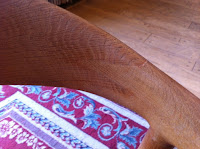Why does my happiness tend to shift, despite the fact that very few actual differences have occurred from Happy Day to Less-Happy Day? Situations and conditions are the same. But one day I'm happy, the next I'm kind of blue. I prefer happy. So how can I stay there? Why does happiness seem so dysmorphic?
Seems like a fairly simple question.
I started at the most obvious place. It's a subject that can cause certain levels of stress in almost everyone. Money. How we see it, value it, are controlled by it, how money plays into the happiness game. Specifically, I referenced an article I'd heard about that attempted to shed light on the perennial dark question that lurks in the murky minds of most folks who struggle every month attempting to balance income with outgo. Does money really buy happiness?
According to a recent TIME magazine article http://www.time.com/time/magazine/article/0,9171,2019628,00.html, happiness may come at a price. It's an interesting study, this link between income and happiness. Although there are many components to happiness, this research has found that "every 10% rise in annual income moves people up the satisfaction ladder the same amount, whether they're making $25,000 or $100,000."
Another TIME piece from a few years back goes into a bit more detail about the specifics when it comes to happiness http://www.time.com/time/magazine/article/0,9171,1015902-1,00.html. Apparently our education, age, religion, marital status and so many more elements are woven into the fabric of our cozy statistical happiness blanket. It seems that happiness itself has been nicely quantified, studied, tucked in and put to bed.
Take, for instance, the TED talk on the paradox of choice by Barry Schwartz http://www.ted.com/talks/barry_schwartz_on_the_paradox_of_choice.html. It's his contention that people are generally less satisfied - less happy - when they have more choices. According to Schwartz, "The more options there are, the easier it is to regret anything at all that is disappointing about the option that you chose."
To sum his talk up in a teeny nutshell, the secret to happiness is low expectations, according to Schwartz.
This theory adds a delicious, fatty layer to the concept of happiness dysmorphia. The element of perception.
How we see things - how we value money, act our age, perceive our station in the world, how we treat people - can be just as important to the process of perceiving happiness as all the data that suggests happiness is an outside job.
Consider this list of "15 Things You Should Give Up to Be Happy" http://www.purposefairy.com/3308/15-things-you-should-give-up-in-order-to-be-happy/. Of all the information I've referenced, all the data I've considered, this particular list is the most compelling.
Give up the need to always to be right. Give up complaining. Give up your limiting beliefs. There are a dozen more items that add yet another comfortable layer to the idea that the dysmorphia of happiness is perception. How we see what we have, how we treat who we love, how we see what we do, what comes out of our mouths, how we navigate the world, directly correlates to happiness.
And those delicious elements have nothing to do with wealth, status, age or religion, blah, blah, blah. It's most likely much more simple.
I've asked several people how they perceive happiness, and those conversations were compelling. Themes emerged. And almost every theme ultimately led back to perception - how we see ourselves, our circumstances and the world - as the source of happiness.
It seems to be as simple as that.
So, like my recent tug-of-war happiness battle, the Quest for Happiness seems to be an ongoing game that requires my participation. It seems to hinge on how I see it in the mirror that's my life. Like that very thin person who finally sees their quest for perfection will never be attained and a sandwich sounds like a good idea, the dysmorphia of happiness is a choice. A perception.
That idea makes me happy.







